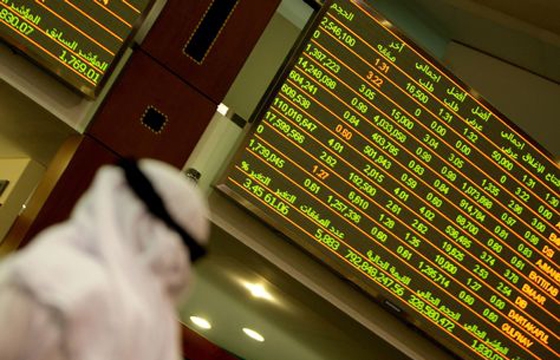While the year ahead could prove to be a bumpy one for global financial markets amid ongoing political and policy risks, there is reason for optimism over the outlook for stocks in the Middle East and North Africa (MENA) region.
Compared to 2016, a number of structural tailwinds should give investors greater confidence in MENA’s fundamentals.
The implementation of major fiscal and capital market reform throughout the region continues to impress markets, while the two major global transmission mechanisms – the US dollar and crude oil prices – are now working in MENA’s favor.
In the context of emerging markets – where 2017 prospects have dimmed due to ongoing US dollar strength and the potential for new trade tensions – the outlook for MENA stocks is bright. Steady corporate earnings growth, undemanding stock valuations and attractive dividend yields, relative to other emerging markets, make the region appealing for investors.
Of course, this is not to say local equity market performance this year will be linear. Global investment risks remain significant. Uncertainty abounds over US President-elect Donald Trump’s economic agenda and its impact on global trade, while years of ultra-easy US monetary look set to be reversed, potentially fueling more US dollar gains. Rising populism is another key theme we see playing out in global markets, ensuring that the risk premium placed on equities remains elevated in 2017.
But even in the face of such headwinds, MENA stocks remain better positioned than their emerging market peers.
Over the past 12 months the MENA region has taken bold steps to implement much needed fiscal and capital market change. Governments have been forced to consider new ways of reducing their dependence on hydrocarbons, without completely sacrificing economic growth. A Value Added Tax (VAT) across the Gulf Cooperation Council (GCC) remains on the agenda for 2018, while corporation tax is also being considered.
In Saudi Arabia, the Vision 2030 document provided a blueprint for modernizing the economy by cutting the kingdom’s dependence on oil, lowering government subsidies, and stimulating the private sector. Amid a range of measures, the government raised fuel prices by 50 percent in December 2015 and cut government payrolls – Saudi’s most significant recurring spending item.
The recently announced 2017 budget highlighted just how serious the country is in its bid to reduce wasteful spending. The results of fiscal constraint show actual expenditure in 2016 declined by 15 percent compared to 2015 and by 28 percent compared to 2014. After two years of belt-tightening, Saudi has now budgeted for an 8 percent increase in spending in 2017, targeting key growth areas like healthcare, mining and education. The end goal is to eliminate Saudi’s fiscal deficit by 2020.
Elsewhere, in Oman and Bahrain, energy and water subsidies have been cut, fuel prices raised by 50-60 percent and government spending scaled back. Egypt, meanwhile, finalized a $12bn deal with the International Monetary Fund (IMF) in November 2016 after floating its currency and cutting subsidies. In our view, Egypt offers one of MENA’s strongest growth profiles due to years of limited investment and an ever-expanding population, which created pent-up demand for basic goods and services.
Beyond fiscal reforms, further capital market liberalization in MENA could prove supportive for the region’s stock markets in 2017, especially as Saudi Arabia and Kuwait work towards inclusion in the MSCI Emerging Markets Index (MSCI EM). With hundreds of billions of dollars in active and passively managed money tracking it, MSCI’s EM Index is a significant dictator of where equity market money flows.
Make no mistake, MSCI inclusion would be a big deal. In terms of MSCI EM weighting, if Saudi was to be included today, it would represent about 3 percent of the benchmark index. The potential IPO of Saudi Aramco, even at the lower end of valuations, could add another 3 percent to this, helping eliminate what we have viewed as a material disconnect between the region’s gross domestic product (GDP) contribution and its representation in MSCI EM.
Complementing the region’s ambitious reform agenda, as well as enhancing MENA’s investment case, is the twin fillip of ongoing US dollar strength and firmer crude oil prices.
In terms of a strong Greenback, the region’s dependence on foreign capital, mostly through dollar denominated sovereign debt, remains measured and forms only a small part of its overall funding. Countries in the region still have a low debt-to-GDP ratio compared to other emerging market constituents, making them far less vulnerable to a rising dollar. The strong currency also adds to the appeal of local equities given that most GCC economies are pegged to the dollar, a relationship in our opinion that is unlikely to change in the foreseeable future.
The other major factor working in MENA’s favor is the price of crude oil. The region’s hydrocarbon-dependent economies have benefited from a rally in oil prices that saw ICE Brent futures surge over 52 percent last year, the biggest annual gain since 2009, according to Bloomberg. Depending on compliance, the recent OPEC agreement to cut global production increases the likelihood that a lingering oversupply in the oil market will be eliminated, providing a positive backdrop for oil prices, and a much needed boost to the region’s finances.
Although the global backdrop for 2017 is mired in uncertainty, within the context of emerging markets the MENA region still offers good value for investors. And with fiscal and capital market reform still firmly on the agenda, MENA equities might just provide the comfort and resistance that investors crave in volatile times.
Arabian Business
24 January























































